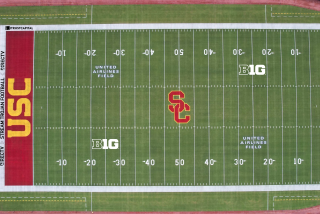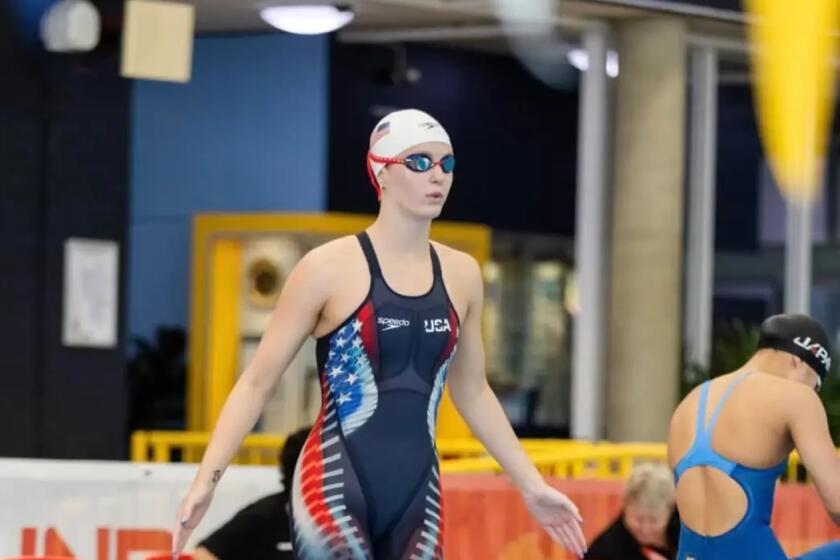Deal Gives Freedom a Boost
- Share via
Every year, a Freedom Bowl either lives or dies, a survival rate dependent upon the autumnal laws of irrational selection.
How a Freedom Bowl lives:
1. Pac-10 team from California says yes to Freedom Bowl.
2. Pac-10 team from California plays in Freedom Bowl.
3. Freedom Bowl draws 51,000.
How a Freedom Bowl dies:
1. Pac-10 team from California says yes to Freedom Bowl.
2. Pac-10 team from California says, wait a minute, the Aloha Bowl just called and it’s offering a TV package that will set us up for years.
3. Freedom Bowl winds up with Tulsa.
For Don Andersen, Freedom Bowl executive director and deal-maker, the diagnosis was much simpler than the prescription. How did Andersen spell relief? “USC” or “UCLA” for starters--and, lacking that, “Cal” or “Stanford,” local anesthesia in the face of those dread diseases, Red Ink and Empty Seats.
But the variable needed to become a constant, and after months of research, Andersen and his staff may have lucked into a cure, assuming the University of Washington retains its status as national championship contender and Oregon State doesn’t shoot up through the standings any time soon.
Wednesday, the Freedom Bowl and the Pac-10 reached an agreement that will send the conference’s third-place team to Anaheim, with no strings or escape clauses attached, for the next two years.
And what that means, according to Andersen, is that, “If you roll the dice, the odds are that we’ll be getting a Pac-10 California team in our game more often than not.”
Andersen is so excited that he has worked it out.
“If this agreement had been in place the last 15 years,” Andersen says, “we’d have had USC three times, Washington three times, Cal twice and UCLA twice.”
As it stands today, after eight Freedom Bowls, the game has had UCLA once--in Freedom III in 1986. “Our most successful game ever, far and away,” Andersen says. More than 56,000 tickets were sold for that abbreviated matchup, UCLA-BYU, and more than 51,000 were actually used.
Contrast that to Freedom VIII last December, after Stanford left Andersen stranded and stuck with a highly resistible matchup of Tulsa and San Diego State. Paid attendance: 42,497--and that was because each school agreed to buy 12,000 tickets up front. In-house attendance: 34,217--or, more out of house than in.
“If we’d had this agreement last year, we’d have had Cal ,” Andersen says, his voice nearly hushed. “A 9-2 Cal team that ended up going down to the Citrus Bowl on New Year’s Day and beating Clemson.”
A 9-2 Cal team, more importantly, that had Russell White taking handoffs from Fullerton boy-made-good Mike Pawlawski.
The possibilities, if not endless, would have certainly taken the turnstiles beyond 50,000.
No business is recession-proof, not even the $64.5-million bowl business, and the unpredictability of these economic times worked to the Freedom Bowl’s favor as Pac-10 officials warily weighed the future.
“I think the Pac-10 got interested in the thing,” Andersen says, “because over the next few years, a couple of bowl games are in major danger of going by the wayside. The Copper Bowl is just getting by on a shoestring. The Aloha Bowl’s got some great difficulties. . . .
“The Pac-10 was looking at a future with fewer bowl games in existence, and our deal assures them of having three teams locked into bowl games, same as the Big 10. I think that really appealed to them.”
One Pac-10 team, of course, is locked into the Rose Bowl. And now, the second-place finisher is committed to either the Blockbuster Bowl, the John Hancock Bowl or the Gator Bowl under a new confederation known as “Coalition II,” the second wave of bowl alliance fever.
“Coalition I” ties Notre Dame and the regular-season champions of five conferences (Big East, Big Eight, Atlantic Coast, Southwest and Southeast) to the Sugar, Orange Cotton and Fiesta bowls. “Coalition II” forges a similar agreement between the second-place finishers from five conferences (Big East, Big Eight, Atlantic Coast, Southwest and Pac-10) and the Blockbuster, Hancock and Gator Bowls.
Lacking the resources ($1 million-per-team payouts) to buy into “Coalition I,” the Freedom Bowl arranged a coalition of its own--one bowl, one conference--and will pay $700,000 this year to the Pac-10’s third-place team and an at-large opponent of Andersen’s choice.
Linked officially now to the Pac-10, Andersen is hopeful of choices extending outside the Oklahoma state boundaries.
“We just see nothing but positives in it,” Andersen says. “Local credibility is the single most important objective we have and you saw the headlines this morning--’Freedom Bowl and Pac-10 Tie The Knot.’ Other schools see that and the Freedom Bowl becomes more attractive to them.
“It also helps us in selling corporate sponsorships, in putting television packages together, in selling tickets. We’re going to be in all the Pac-10 media guides this year--’This is where our third-place team goes.’ Heck, we’re going to be on the same page as the Rose Bowl.”
And we thought the Freedom Bowl would never live to see the day.
More to Read
Go beyond the scoreboard
Get the latest on L.A.'s teams in the daily Sports Report newsletter.
You may occasionally receive promotional content from the Los Angeles Times.










